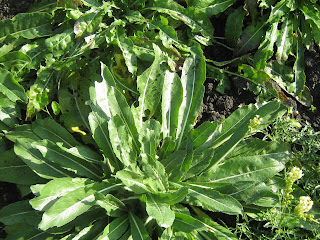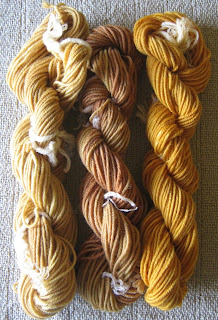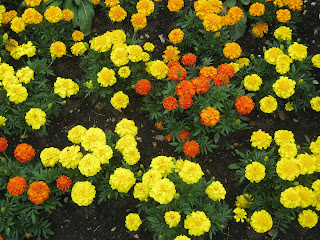Wednesday, 13 December 2017
The End
With the closing of my last exhibition in the MK 50 Roadshow, this project has reached a natural conclusion. 2017 has been a stimulating and eventful year, and I have learned a great deal about natural dyeing and ecological processes. In the New Year, some of my bolts of cloth will be exhibited again in MK's Main Library, as part of a larger celebration of MK 50. In 2018, I shall move on to making the cloth up into eight dresses, each named for a Saint who is associated with the appropriate season of the Celtic year, as part of All Saints' Loughton's 800th birthday celebration. They will be on display in the church, alongside a Flower Festival, throughout Heritage Weekend in September 2018. Its high time to get sewing!
Monday, 27 November 2017
Yule
It is the opening of the final phase of the MK Makers' Roadshow this weekend, at the Three Hares Gallery in the Cowper Museum in Olney. I have managed to complete my Yule weaving (featuring mainly various colours derived from madder and woad) in time for the opening, so I shall be able to show all eight weavings that, taken together, represent the seasonal colours of Loughton. It has been a mammoth task, and I'm pleased finally to have reached the conclusion of the project.
Friday, 20 October 2017
Samhain
Samhain (pronounced Sow-en) is the third Celtic harvest festival that marks summer’s end and celebrates the gathering in of fruits of the earth such as pumpkins, gourds, turnips, parsnips and swedes, the storing of nuts and dried herbs and, in past times, the slaughter of those animals that could not survive through the long, cruel winter. Situated between the Autumn Equinox and the Winter Solstice, it incorporates All Hallows Eve (October 31st), All Saints’ Day (November 1st) and All Souls’ Day (November 2nd). Before it became commercialised, Hallowe’en used to be thought of as a time when the veil separating the living and the dead became thin, so that the ancestors drew closer and the dead were remembered. Bonfires were lit to counter the waning power of the sun, as the days became shorter and colder. Many local customs involved playing tricks or making mischief whilst processing door-to-door and also divination or scrying, to see into the future. These have now been reimagined in the children’s pastime of ‘trick or treat’. All Saints’ Day, commemorating the Christian martyrs, dates from the fourth century and was fixed on November 1st by about AD 800. All Souls’ Day, which falls on November 2nd and is an occasion on which to remember our dead loved ones, is more recent, dating from AD 998 when Odilo, Abbot of Cluny, held a mass for all dead souls. It used to be believed that both the saints and the living could intercede for the dead, who were thought to be in Purgatory atoning for the sins they had committed during their lives on earth. Intercession would speed their progress towards Heaven.These beliefs lost ground after the Reformation, but were revived in the nineteenth century and are now standard feasts in the more sacramental churches. All Souls is a sombre festival at which the names of the departed are recited; All Saints is more spectacular and colourful ceremony at which the lives and example provided by saints and martyrs are recalled and celebrated. My Samhain weaving takes its colour palette from the fruits of the earth and its textures from the bark of trees.
Thursday, 21 September 2017
Mabon
Mabon is a Celtic Fire Festival celebrated on September 20, 21, or 22, depending on when the Autumn Equinox falls and the length of day and of night are once more in perfect balance. So like its polar opposite, Ostara, Mabon marks a turning point, only instead of turning outward towards the coming Summer we begin to focus inward, as we prepare for the long, dark Winter to come. Mabon is the great festival of Autumn’s end. From now on the days will get shorter and the weather colder. Astrologically, it occurs under the sign of Libra - the Balance - my own birth sign and a fitting symbol of balanced light and darkness. In Rome, this equinox marked the festival of Dionysus, the God of Wine and Revelry. In Celtic times, Mabon conceded with the festival of Harvest Home, remembered in today’s church liturgy through our own Harvest Festival services. Mabon celebrates the end of the second harvest of nuts, apples, grapes and berries, and harvest berries and drupes feature in the weft of my Mabon weaving.The dyestuffs in my Mabon weaving include Weld, Weld over dyed with madder to give me orange, Coreopsis and Dyer’s Coreopsis, Tansy, lots of different colours obtained from the French Marigolds that are currently running riot on my allotment, Yarrow, Acer Buckthorn, Flowering Currant, Elderberries, cultivated and wild Blackberries and Sloes. The weft pattern of interlocking purple and gold represents the balance between light and darkness.
Thursday, 14 September 2017
Lammas
Also known as Lughnassa, Lammas, celebrated on August 1st, is the Celtic festival of the first - i.e., grain - harvest of wheat barley rye and oats. The power of the sun goes into the grain as it ripens. It is then harvested and made into the first new bread of the season, which is taken to church, laid on the altar and dedicated during the Loaf Mass, hence Lammas. At this time of year, seed grain is also saved for planting next year's crop, which lies dormant underground during the Winter and rises again in Spring, when the new green shoots sprout, as the sun also rises in the sky. So Lammas is also a time to celebrate resurrection. As well as celebrating the first fruits of the grain harvest, Lammas recognises the fruits of our labours, and seeing the desires that we had at the start of the year unfold. Colours associated with Lammas include gold, yellow and orange. My Lammas weaving is a simple plain weave ombre in tones of greenish gold, dyed from French marigolds, coreopsis, weld, dyer’s chamomile, cosmos, golden rod, St. John’s Wort flowers, alder bark, barberry bark, artichoke leaves, apple leaves, rhubarb leaves sage, domestic carrot and yarrow.
Friday, 25 August 2017
Look what I've made!
I've now filled another drawer with thirty lovely early autumn colours from plants sourced locally in Loughton.
Monday, 21 August 2017
The Dye Garden at Peak Production
From not having had a great many plants to dye with, I've now got a glut of just about everything. I've been freezing batches of French Marigolds to preserve them for later in the year but the more I cut them, the more they come into flower.
The same with the Golden Rod. I've taken a crop of these already, but they have come back into flower.
So have the Cosmos.
My Madder is growing well, but is too young to harvest, as I need to take the roots.
The Gypsywort is growing strongly, but I have not harvested it yet. It is supposed to produce a black dye.
The Woad and the Weld are both doing well. I should be able to take a small crop soon.
My Mallow plants were so small when I bought them that they got lost in the weeds, but now they are rampaging though the plot!
I've already taken a crop form the Rudbeckia, but it is back in flower again.
I took a harvest from the Tansy yesterday, but it has lots of buds coming along.
The same is true of my Yarrow plant.
The only plant that is still to flower is my Coreopsis. The plants in the garden have already given me a crop, but these in the allotment were planted this year as plug plants, and they are only just beginning to flower.
It is so lovely to be able to pick plants that one has grown, and make dyes from them.
The same with the Golden Rod. I've taken a crop of these already, but they have come back into flower.
So have the Cosmos.
My Madder is growing well, but is too young to harvest, as I need to take the roots.
The Gypsywort is growing strongly, but I have not harvested it yet. It is supposed to produce a black dye.
The Woad and the Weld are both doing well. I should be able to take a small crop soon.
My Mallow plants were so small when I bought them that they got lost in the weeds, but now they are rampaging though the plot!
I've already taken a crop form the Rudbeckia, but it is back in flower again.
I took a harvest from the Tansy yesterday, but it has lots of buds coming along.
The same is true of my Yarrow plant.
The only plant that is still to flower is my Coreopsis. The plants in the garden have already given me a crop, but these in the allotment were planted this year as plug plants, and they are only just beginning to flower.
It is so lovely to be able to pick plants that one has grown, and make dyes from them.
Thursday, 17 August 2017
Sloes
I went foraging for sloes yesterday, to add to my palette of late summer skeins of naturally dyed wool. Some blackthorn bushes were loaded with drupes, but others were completely bare. Fortunately I was able to gather sufficient for three skeins. I'm pleased with the lavender and grey shades, but I'm guessing that they won't be completely colourfast. From the left, mordanted with alum, with copper and with alum plus tin.
Tuesday, 15 August 2017
Taking Stock
The year 2017 is two-thirds over already. How time flies! It is time to take stock of where my natural dyeing project based on the colours of Loughton (my home village) has led me. I have finished four weavings (Imbolc, Ostara, Beltane and Litha), and I still have another four to go (Lammas, Mabon, Samhain and Yule). I should have finished Lammas by now, but I'm a bit behind due to having organised a Scarecrow Festival in Loughton and then taken a summer holiday.
The maths is simple. Each weaving comprises 26 warp colours and 26 weft colours. That's 52 skeins per weaving, the same as the number of weeks in a year. Therefore, I need a minimum of 208 skeins to complete the project. I have already wound another warp, reducing that total by 26 skeins, to 182 skeins.
Over the last couple of days, I have wound all the remaining skeins in my stash into balls and sorted them into trays by colour palette. Here they are: 30 x brown and olive green (mainly modified with iron water), at least 30 x madder and woad; 22 x shades of yellow, mostly recent and dyed from late summer flowers; 26 shades of greenish yellow dyed in one step from various local plants and finally 15 x 'Lincoln green' made from various yellow skeins that have been over dyed with woad. That's 123 skeins altogether. I still need to dye another 59 skeins by the end of the year, which seems do-able. I shall be out foraging for blackberries, sloes and elderberries this week in order to make a start.
The maths is simple. Each weaving comprises 26 warp colours and 26 weft colours. That's 52 skeins per weaving, the same as the number of weeks in a year. Therefore, I need a minimum of 208 skeins to complete the project. I have already wound another warp, reducing that total by 26 skeins, to 182 skeins.
Over the last couple of days, I have wound all the remaining skeins in my stash into balls and sorted them into trays by colour palette. Here they are: 30 x brown and olive green (mainly modified with iron water), at least 30 x madder and woad; 22 x shades of yellow, mostly recent and dyed from late summer flowers; 26 shades of greenish yellow dyed in one step from various local plants and finally 15 x 'Lincoln green' made from various yellow skeins that have been over dyed with woad. That's 123 skeins altogether. I still need to dye another 59 skeins by the end of the year, which seems do-able. I shall be out foraging for blackberries, sloes and elderberries this week in order to make a start.
More Madder
I've been busy with a short course on Eco-printing, for which I had to buy some madder extract. I thought I'd see if it made a difference to the colours I obtained, as I've not been managing to get a good red from madder roots. The extract gave me some delightfully intense colours with alum, copper and tin mordants, and also when I over dyed some of my woad skeins that I thought were a bit insipid. It is well worth experimenting!
Sunday, 13 August 2017
Late Summer Flowers
The results of yesterday's harvest are interesting, as always. The Coreopsis yielded some quite strong orange shades; Yellow Cosmos, by far the palest flower, gave me good range of yellow tones; and the Rudbeckia (the most intense flower heads in shades of gold and brown) gave me three soft greens. You just never know! From the left, each set was mordanted with alum, copper and alum plus tin. I've decided not to use iron to 'sadden' a fourth skein, as the result is always brown or deep olive green. I have enough of these skeins to finish the project, so for the time being I'll concentrate on dyeing brighter, happier colours.
Saturday, 12 August 2017
This Morning's Harvest
Rudbeckia, Yellow Cosmos and Dyer's Coreopsis, simmering on my hob. I wonder what colours these will yield? Can't wait to find out!
Thursday, 27 July 2017
Tuesday, 18 July 2017
More Marigolds
I processed my yellow marigolds and my variegated orange / rusty red coloured ones separately, to see if they yielded different colours. They did, but not as I'd expected! The yellow ones gave me some really intense colours, but the variegated ones produced a much paler dye than I could have predicted. Natural dyeing never stops producing surprises.
Monday, 17 July 2017
Golden Rod
This is the result from dyeing with Solidago tops, aka Golden Rod. From the left, mordanted with alum, with copper, with alum + tin, and finally alum + iron.
Saturday, 15 July 2017
Orange French Marigolds
I've separated my marigold heads into three separate colours for the dye pot. This is what I obtained from the orange ones. From the left, mordanted with alum, copper, alum + tin and alum + iron. It never fails to enchant me to see the wide range of colours that can be obtained from one dye pot. Who says natural dyes are insipid and boring?
Tuesday, 11 July 2017
News From the Dyer's Garden
Everything is blooming in my dyer's garden. I have arrived home from two weeks' cruising from St Petersburg to Moscow, to find the garden a riot of colour.
Yesterday afternoon, I picked 184 French Marigolds, in three colours: yellow, orange and burnt orange, which yielded three separate dye baths. I'm dying (no pun intended) to see what results I obtain when I try my four skein method with each dye pot.
I also picked some Dyer's Chamomile and some Golden Rod (Solidago) , and made two more dye baths from these gleanings.
Elsewhere in the garden, my Ladies' Bedstraw is in flower and so is the Yellow Cosmos, though these flowers are so pale that I wonder if I'll get a decent colour out of them when I have sufficient to make a dye bath.
The Wild Carrot, Mallow and Yarrow are about to flower, too!
The only problem I have right now is how to get rid of the bindweed that is invading the plot. Grrrr!
Yesterday afternoon, I picked 184 French Marigolds, in three colours: yellow, orange and burnt orange, which yielded three separate dye baths. I'm dying (no pun intended) to see what results I obtain when I try my four skein method with each dye pot.
I also picked some Dyer's Chamomile and some Golden Rod (Solidago) , and made two more dye baths from these gleanings.
Elsewhere in the garden, my Ladies' Bedstraw is in flower and so is the Yellow Cosmos, though these flowers are so pale that I wonder if I'll get a decent colour out of them when I have sufficient to make a dye bath.
The Wild Carrot, Mallow and Yarrow are about to flower, too!
The only problem I have right now is how to get rid of the bindweed that is invading the plot. Grrrr!
Subscribe to:
Comments (Atom)






















































